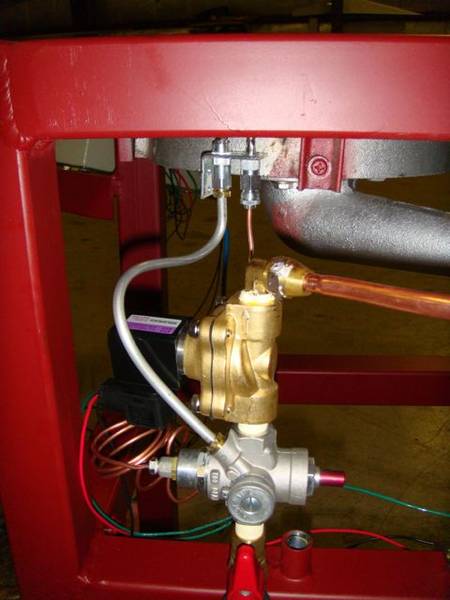"Need" is the operative word here, but since we are talking about automation, then the two main options that have been discussed and are commonly used are: Pilot light w/ safety shut value OR Electronic ignition (spark)
In my assembly above (standing pilot) the components are as follows from bottom up:
BASO Pilot Safety valve
- 2 peripheral connections are the thermocouple (copper lead) and the pilot light gas feed (aluminum tubing). Thermocouple sits in the pilot light and heats up. If flame is ON, then thermocouple is hot and opens valve providing gas to flow to the next component. If pilot goes out via wind, boil over, etc. then thermocouple cools and shuts gas valve so you don't go BOOM.
Gas Solenoid valve (STC or ASCO or other
This is a normally closed solenoid valve that is controlled via a switch. No different than a toggle switch. But in this case we use the Love Switch that is controlled via a temperature setting. The Loves are technically a switch. I know they are referred to as a controller. But they don't control anything. They simply open or close a circuit based on parameters set to monitor temperature, its a automated switch. Temp gets too low...the 'switch' make contact, closes the circuit which opens the valve allowing gas to flow to burner which in turn is ignited by the pilot light..VWOOOOF !!! Flame On !!
The solenoid valve is wired to your control panel and a toggle switch that controls master power to the swtich. You dont NEED to do it this way, but I like to turn off the power to the solenoid valve and still be able to use the LOVE switch to monitor temps.
Hope that helps...

















![Craft A Brew - Safale S-04 Dry Yeast - Fermentis - English Ale Dry Yeast - For English and American Ales and Hard Apple Ciders - Ingredients for Home Brewing - Beer Making Supplies - [1 Pack]](https://m.media-amazon.com/images/I/41fVGNh6JfL._SL500_.jpg)








































